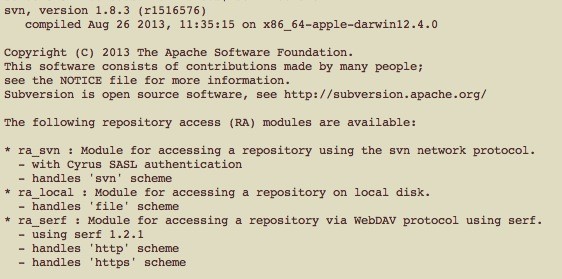
- #COMMAND LINE FOR MAC SVN SOFTWARE#
- #COMMAND LINE FOR MAC SVN FREE#
- #COMMAND LINE FOR MAC SVN WINDOWS#
So it will help you to learn SVN quickly. I have started this tutorial from scratch. We have developed this SVN tutorial for beginners and professionals both.
#COMMAND LINE FOR MAC SVN SOFTWARE#
So it will be better to have some amount of exposure to the software development life cycle (SDLC) and working knowledge of developing web-based and non-web-based applications. In SVN, You are going to handle all levels of programming-based projects.
#COMMAND LINE FOR MAC SVN WINDOWS#
You have a basic understanding of Windows commands. SVN is not a programming language, so you don't need to much worry about essential knowledge.
#COMMAND LINE FOR MAC SVN FREE#
SVN client is free and open-source.Ĭurrently, some supported clients are Tortoise SVN, Collabnet, and Visual SVN clients. It provides the interface that helps and allows us to interact with the server. It is a tool that is installed on the user machine to communicate with the SVN server.


It is a tool that is installed in the user machine. The client acts as the browser that accesses the data on the server. These components can be considered as web servers and web browsers. There are two core components of SVN they are as follows: It has a standalone server option (svnserver).It has language bindings for some programming languages like C#, Perl, Ruby, PHP, Python, and Java.It provides versioning of symbolic links.It provides file locking for the files that cannot be merged.It supports Internationalized program message.It supports atomic commits (Either it will occur or not).In 2009, Apache Incubator accepted it and made it a top-level apache product. It was operated much like CVS (Concurrent versions system). Subversion is open-source and comes under the Apache License, and it was developed by CollabNet Inc in 2000. Some other popular version control systems like Git are in trend now, but there are a large number of projects that are still running on the Subversion. It acts as the time machine for the developers and allows them to go back and browse the history of the project.

SVN is used to manage the current and previous versions of files like source code, documentation, and files. It is an open-source tool for version control. It is a centralized version control system. It is called as SVN because of its commands (its command name svn). The examples were done on windows, but should also work on other operating systems like Linux (Ubuntu) and Mac. This tutorial helps you to understand the Centralized version control system. The version control allows you to track and work together with your team members at the same workspace. It is developed to co-ordinate the work among programmers. It is designed to handle minor to major projects with speed and efficiency. SVN is an open-source centralized version control system that is available for everyone at zero cost. Our SVN tutorial is designed for beginners and professionals. SVN tutorial provides basic and advanced concepts of SVN.


 0 kommentar(er)
0 kommentar(er)
